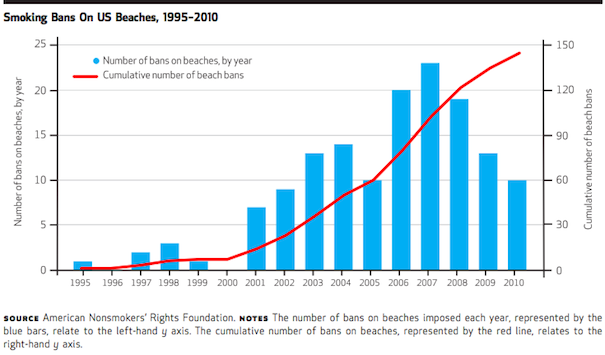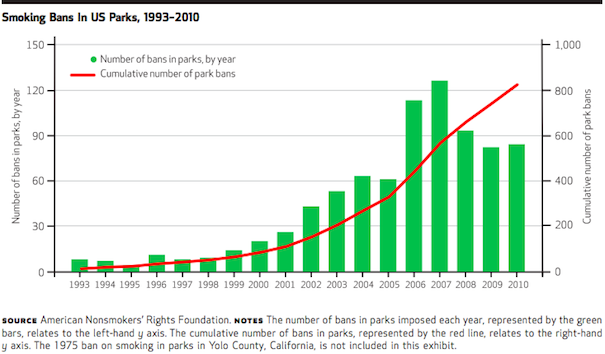It Only Took About 20 Years for the U.S. to Turn Smokers into Pariahs
The public smoking ban is a relatively recent invention. The first outdoor ban identified by the American Nonsmokers' Rights Foundation was put in place in 1975 in Yolo County, Calif., which outlawed smoking in all public parks. The idea didn't exactly take off. Another two decades would go by before the policy — in public parks, on beaches, in children's playgrounds — would spread around California and then throughout the U.S., rapidly transforming a once-acceptable social norm into something hazardous to your kids, your lungs and the environment.
RELATED: It's Time to Lay Off the Morning Cigarette
In the late '90s, communities in Massachusetts and Rhode Island created the first beach smoking bans. By 2006, seven more states had them as well. By 2011, 23 states did. The rise of the park smoking ban has been even more dramatic: By June of 2011, municipalities in all 50 states had them.
RELATED: A Few New Yorkers Will Go to Great Lengths to Keep Smoking
MORE FROM THE ATLANTIC CITIES
Your Sedentary Lifestyle Is Turning You Into a Nervous Wreck
Prepare To Waste Your Day With This Fascinating City Comparison Tool
But despite this impressive trajectory – and the abrupt shift in public perception that has accompanied it – public-health researchers argue that there's actually not a lot of scientific evidence backing up popular justifications for smoking bans. In the July issue of the journal Health Affairs, Columbia University's Ronald Bayer and Kathleen E. Bachynski pick apart three of the most common arguments: Public bans reduce second-hand smoke that endangers non-smokers. They reduce cigarette-butt litter that's toxic to the environment. And they take cigarettes out of the public view of impressionable children.
RELATED: Gallup: Americans Now Favor Banning Smoking From All Public Places
"Banning Smoking In Parks And On Beaches: Science, Policy, And The Politics Of Denormalization" by R. Bayer and K. Bachynski in Health Affairs.
RELATED: The Case of Too Many Facebook Friends; Smoking Rots the Brain
In reality, smoking bans probably do more to protect smokers themselves than the people around them. But it sounds less paternalistic to implement these policies in the name of shielding children. The short history of how these alternate arguments have become conventional wisdom reveals, Bayer and Bachynski write, "the complex relationships among scientific evidence, real-world health risks, and politics in the public policy process of denormalization."
RELATED: Smoking Offers at Least One Health Benefit
In their own analysis of a national database maintained by the American Nonsmokers' Rights Foundation, Bayer and Bachynski count 843 park bans and 150 beach bans imposed in the U.S. between 1993-2011. The largest share came from California, then Minnesota and New Jersey.
The scientific community, meanwhile, either hasn't kept pace with research on the effects of such bans, or hasn't found conclusive evidence of connections between second-hand smoke and some health impacts, like breast cancer. In fact, the American Lung Association, the American Heart Association and the American Cancer Society have all shied away from supporting such bans, in favor of public-health policies they believe would be more effective, like higher cigarette taxes, or tighter restrictions of tobacco ad campaigns.
In an interview with the researchers, one official with the American Lung Association put it this way: “I don’t think we should be making claims that are not supported by the data. If you try to tie it [banning smoking on beaches or in parks] to a health outcome, that’s where you get in trouble.”
The litter argument is more compelling, although it stretches farther than science has gone with the notion that cigarette butts do real damage to ecosystems (or to animals and children thought to frequently ingest them). As for the societal influence of smokers on children – research says they primarily take their cues from their parents, not strangers they see on the beach.
"Banning Smoking In Parks And On Beaches: Science, Policy, And The Politics Of Denormalization" by R. Bayer and K. Bachynski in Health Affairs.
Of course, there's a strong if politically unpalatable argument for enacting these policies: Over time, smoking bans have helped turn cigarette butts into something disgusting, and smokers themselves into pariahs. Smoking bans help change smoking norms. And polls suggest that the shift in public opinion has been swift. Gallup began asking people in 2001 if they supported making smoking illegal in public spaces. Then, only 39 percent of people did. As of 2011, for the first time, a majority did, at 59 percent.
"Denormalization," Bayer and Bachynski write, is the sanitized term for policies that actively seek to stigmatize smoking. Depending on your view of the lengths we should go to cut down on the known health consequences of tobacco, you may be OK with this. But Bayer and Bachynski warn that it's a "perilous strategy" to mask that goal with weak arguments about protecting the children from bad influence, or their parents from second-hand smoke.



